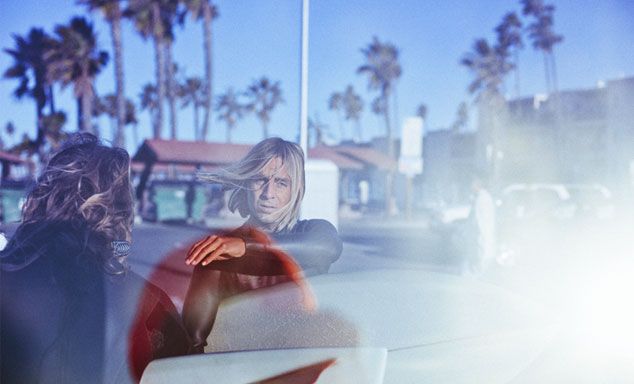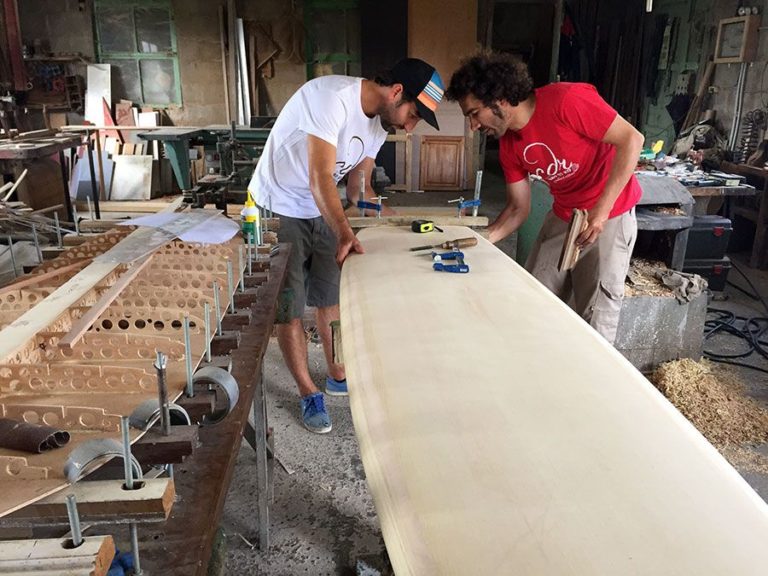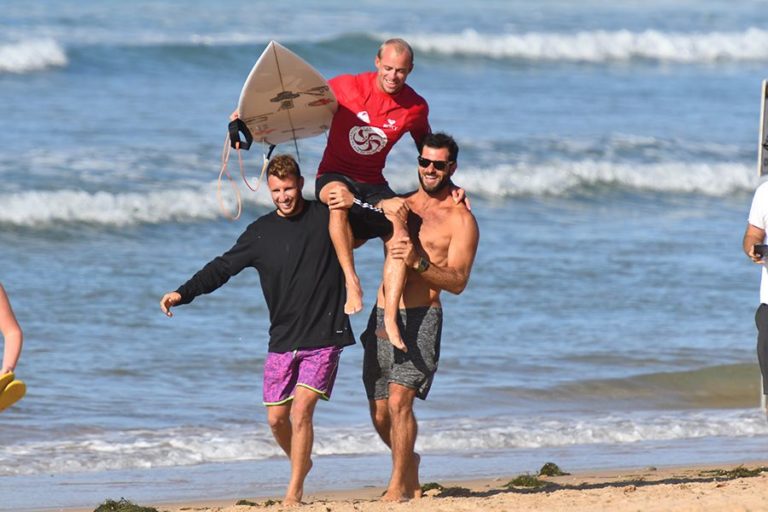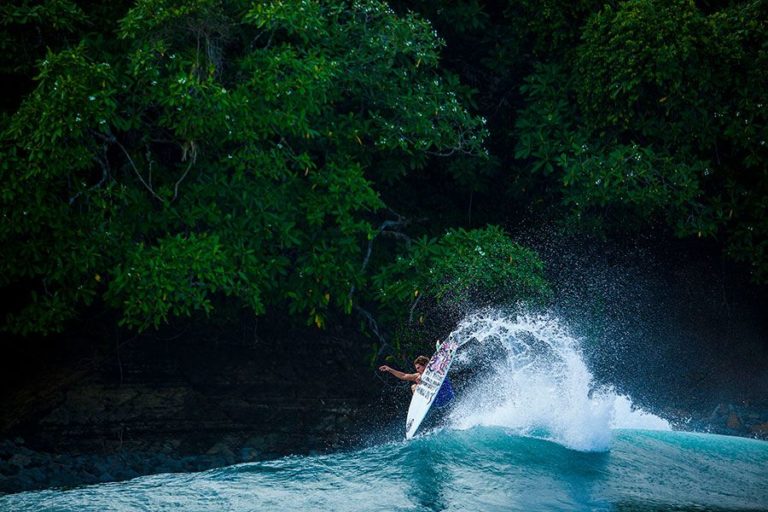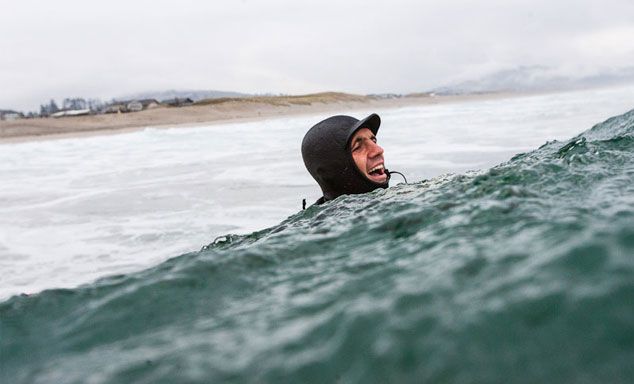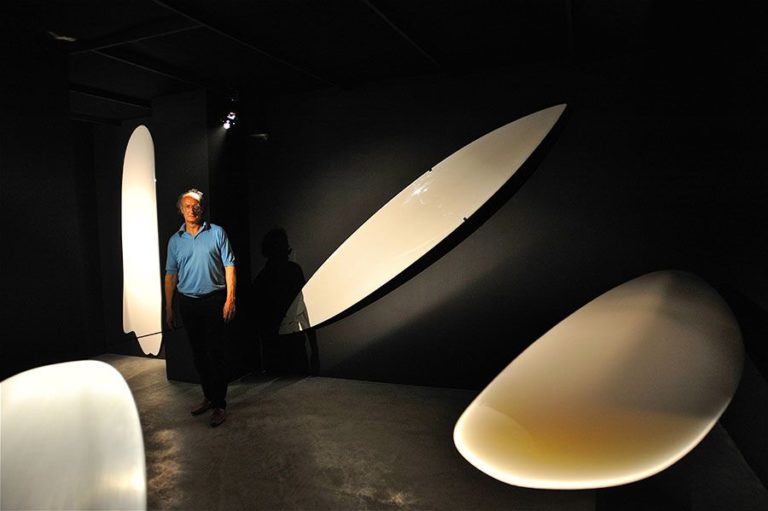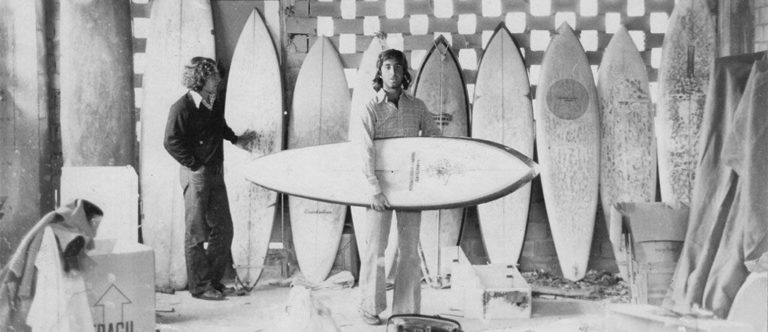Spoons: la reinvención del surf
5 March 2021 Texto: AES Rando. Fotografía: Archivo Spoons. foto portada: Bruce Brown looking through old cans of footage on his reel-to-reel film editor. Cred: Image from the Film "Spoons: A Santa Barbara Story".
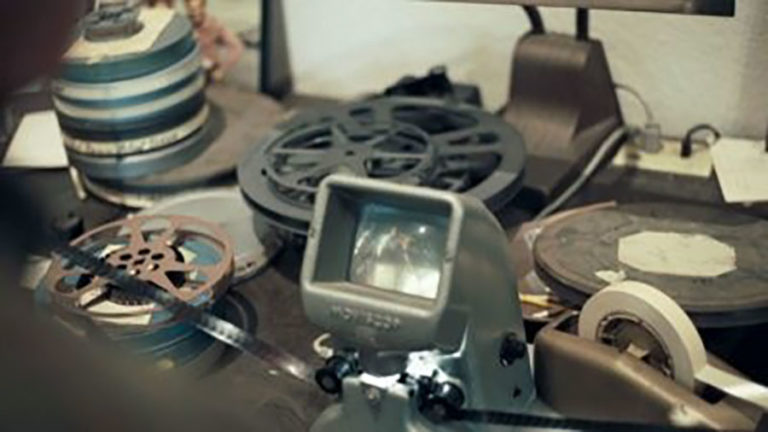
{english below} Es verdad que cuando ocurren las cosas normalmente no es por casualidad. Alrededor de la ola de Rincon un grupo de surfers y shapers empezaron a experimentar con las formas de las tablas y cómo estas nuevas formas cambiaron también la forma de surfear. Recordemos que en esa zona de Santa Barbara estaban dos shapers capitales para la evolución del surfing como son Yater y Greennough. Y es esta evolución lo que vamos a ver en este documental en las voces de los propios protagonistas , donde nos cuentan cómo fueron cambiando las formas de las tablas para ir consiguiendo un surf más moderno. Una época excitante tanto en el surf como socialmente y que queda perfectamente reflejado en este documental.

Unknown heading out circa 1973. Credit: Glen Clark Archive
La génesis de Spoonsla encontramos en la digitalización del archivo del Rincon Classic surf ¿cuándo te diste cuenta que tenías una historia para contar?
Cuando entrevistamos por primera vez a Renny Yater en 2013, nos habló de la transición del shaping de madera de balsa al foam, y de cómo participó en el desarrollo de las piezas de foam con Grubby Clark. Habló de la pesca de langosta con George Greenough. Rápidamente me di cuenta de que estaba hablando con un vínculo directo con el pasado del surf, y de que había mucho más de lo que se podía hablar que sobre algún concurso local.
¿En la época qué era lo que diferenciaba Rincon de otras escenas surfing de California?
Cuando Renny se mudó a Santa Bárbara en 1959, Santa Bárbara era vista como “el ártico”. Esto fue antes de los trajes de neopreno, y aunque tipos como Bob Simmons, Tom Blake y Gates Foss surfeaban en Rincón, las principales escenas de surf en California giraban en torno a los rompientes del sur de California, Malibú, Windansea y San Onofre. Aquí es donde el estilo de vida del Beach Boy se afianzó y se hizo comercial. A medida que Hollywood se introdujo en el juego, el surf comenzó a ganar relevancia cultural como un movimiento juvenil contracultural. Pero una vez que Renny se mudó a Santa Bárbara justo en la transición a las tablas de surf de foam, comenzó a crear tablas de surf con perfiles más refinados de rockers y rieles que se desempeñaban mejor en Rincón que las tablas creadas para Malibú.

Gates Foss, first photographed surfer at Rincon. Credit: Roger Nance Archive
En pocos documentales vemos alusiones al contexto social y político ¿hasta qué punto influyó en el estilo de surfing de esos años?
El surf fue hecho por los contraculturistas. Tipos como Bob Cooper personifican la confluencia del arte y la expresión y el surf. Cooper era un beatnik. Debería ser canonizado.
De todos esos elementos contraculturales que caracterizaron al surfing ¿qué crees que nos queda?
El actual renacimiento de la construcción de tu propio equipo es súper emocionante e importante para la cultura. La gente habla de las tablas de surf de longitud media o de las twin fins como “retro”, pero son sólo un instrumento más. Cada uno hace su propia música. A algunas personas les gusta la guitarra eléctrica, pero no es lo que todo el mundo quiere. Los gustos musicales cambian. También los gustos del surf. Y si no estás dispuesto a evolucionar puedes ser uno de esos desafortunados que dejan de surfear porque no pueden surfear una tabla corta en la vejez.

Gates Foss, first photographed surfer at Rincon. Credit: Roger Nance Archive
¿Y qué crees que se ha perdido en el surf actual?
Es difícil decir lo que se ha perdido, porque yo no estaba vivo en la Era Dorada. Pero en mi opinión, el surf es una cuestión de arte, creatividad y expresión. A veces eso se manifiesta en el surf de “alto rendimiento”. A veces eso es hacer un buen giro en una tabla de surf de longitud media. Es una relación para toda la vida si tienes suerte. Siempre que alguien está surfeando por una razón que no sea su propio disfrute personal, ha perdido algo.
Tanto en el cine convencional como en el documental veo una cierta tendencia a la nostalgia ¿cualquier tiempo pasado nos parece mejor?
Odio la idea de la nostalgia si está siendo utilizada por personas que no tienen un recuerdo de lo que son nostálgicos. De lo que realmente estamos hablando es de estar inspirados por el pasado. Esta es una distinción importante, porque podemos inspirarnos en el pasado y crear algo nuevo. Pero si estamos tratando de “recapturar el pasado” es mejor que sepamos lo que estamos tratando de recapturar, de lo contrario estamos simplemente imitando. La imitación está bien, pero no es lo que me interesa. Pero, ¿por qué nos inspiramos en el pasado? Esa es una pregunta difícil, y tiene una respuesta diferente para cada persona. Un buen ejemplo para nosotros fue la decisión de grabar con mucha película en este rodaje. Rodar con película nos ayudó a conseguir un aspecto específico que se mezclaba bien con nuestro material de archivo, y nos proporcionó increíbles oportunidades de aprendizaje como cineastas. E hicimos algo nuevo. Pero encuentro inspiración en todas las áreas, y definitivamente no estoy interesado en recapturar algo de lo que no tengo experiencia directa.

George Greenough painting Morning Light. Credit: Crystal Voyager dir David Elfick
En Spoons vemos una época muy concreta en la historia del surf en Santa Bárbara, donde convergen diferentes formas de entender el surf y todas muy creativas¿piensas que ahora está todo más estandarizado?
Bueno, las cosas están definitivamente más estandarizadas cuando se piensa en el modelado CNC y la producción en masa de las fábricas. Además, ver las tablas de surf Wavestorm en todos los lineup de California es angustioso. Por un lado, aprecio que más gente tenga acceso a aprender sobre la sensación que nos da el surf, porque en cierto nivel todos estamos persiguiendo la misma sensación que nos da el deslizarnos. La sensación de un pequeño impulso de velocidad, o un buen giro, o simplemente de estar sano en el agua. Eso es genial, y debería ser difundido a la mayor cantidad de gente posible porque es bueno para la humanidad. Pero también creo que los pequeños shapers independientes y de patio trasero son el núcleo de la cultura del surf. Son la conexión directa con el pasado del surf, y deben ser celebrados y preservados. Ellos mantienen la artesanía. Esto no tiene por qué ser mutuamente excluyente con el surf de rendimiento, o el shaping CNC. Ambos pueden y deben existir. Pero si estás surfeando en una Wavestorm y sabes surfear bien, no creo que se te deba dar el mismo respeto que si estuvieras montando una tabla de surf que representa a la comunidad de surfistas. Cuando gastas dinero en el surf, debería volver a la cultura del surf para ayudarnos a mantenernos fuertes. Es como comprar comida orgánica o local. Es mejor para todos.

George Greenough laminating Carbon Fiber for a windsurfer Circa 1983. VHS. Credit: Charlie Coffee Archive
¿Dónde ves ahora la creatividad en la industria del surf?
Hay mucha creatividad en la investigación de los diseños de longitud media. Encontrar formas de esconder el foam en una tabla de surf manteniendo el shape y trabajando con la forma de los cantos es muy interesante. Ryan Lovelace y Ryan Burch están haciendo tablas que dan a la gente una sensación diferente. Pero ver lo que Jon Pyzel ha hecho por la shortboard de alto rendimiento durante la última década es también super interesante. El surf es un arte, y es creativo por defecto. Es sólo otro medio. Los artistas que practican el surf lo llevan a sus otras formas; fotografía, pintura, dibujo, escritura, hacer una forma de foam con herramientas de mano, son todas formas de creatividad.

George Greenough’s collection of spoons. Circa 1983. VHS. Credit: Charlie Coffee Archive
Respecto a la fotografía de surf ¿qué fotógrafos son los que tienen un trabajo más interesante?
Los fotógrafos que tienen el trabajo más interesante capturan un espíritu que repercute en los demás. He sido fan de la obra de Morgan Maassen durante años; lo hace muy bien y no hay duda de por qué se ha hecho tan popular. Crecí mirando el trabajo de Aaron Chang y pienso en Chris Burkard como uno de esos fotógrafos perfectos. Y ahora aprecio a los fotógrafos que experimentan con la forma o miran los lados del surf que no se asocian típicamente con el surf. Mi amiga Dana Shaw tiene un trabajo increíble que ha estado haciendo con película de 35mm; su trabajo captura un espíritu crudo del surf que me encanta. También me gustan los jóvenes fotógrafos que se arriesgan; Soraya Simi es una amiga que me entusiasma ver lo que hace. Tyler Brundage de Newport Beach me hace sentir bien. Michael Townsend es otro. Y ni siquiera me he metido con los cineastas o los clásicos como Bruce Brown y Greg MacGillivray. Encontramos en este proyecto que hay muchos fotógrafos o cineastas talentosos que sólo “disparan por diversión” pero disparan con intención. Y aunque nunca muestren sus fotos a personas más allá de sus amigos y familiares, su trabajo a veces lleva un espíritu que es único. Me gustan las imágenes que me hacen sentir algo.

Marc Andreini with a new shape, Circa 1974. Credit: Greg Huglin
La fotografía de surf en su origen creó una forma de representar el ocio ¿crees que sigue vigente esa forma de representar el surfing?.
Totalmente.
Otro aspecto es la relación surf/utopía ¿fue el surf un actor importante en la contracultura de los 60 en USA?
El Coronel Kilgore en Apocalypse Now es el epítome de la dicotomía del surf en los Estados Unidos.
¿Qué ha quedado de esa contracultura en el mundo del surfing?
El surf siempre será para el individuo más que para el observador. No se encuentran tipos que jueguen al fútbol americano solos antes del trabajo. El surf puede ser espectacular de ver, pero no es un verdadero deporte para espectadores. Es como el golf en ese sentido. En mi opinión, hay que apreciar el arte para poder disfrutar de él. Así que, a medida que seguimos haciendo crecer este “deporte”, es realmente interesante ver cómo evoluciona para captar a los espectadores y al público en general que no tienen ningún entendimiento de lo que están viendo. Desde esa perspectiva, aunque el surf siga creciendo y se haga más popular, siempre habrá gente que lo haga por sí misma. Esos son los individuos, y la individualidad está en el centro de cualquier contracultura.

It wasn’t a lifestyle. It was life with style. Credit: Image from the Film
En la confusa frontera entre el ocio y el consumo ¿sería el surf uno de los últimos lugares habitables que nos quedan?
El surf está en todo el espectro. Es una industria multimillonaria. También es alguien como yo que monta la misma tabla durante 10 años. Y lleva un par de aletas y hace BODYSURFINGING. Puedes hacerlo sin dinero. Es gratis si lo quieres.
¿Qué podríamos hacer desde la fotografía para devolver ese espíritu de libertad al surfing?
Toma fotos de las cosas que te mueven. No tengas miedo de capturar las cosas raras que tal vez sólo tú ves. A veces esas cosas impactan en otras personas. No imites, emula. No te pongas nostálgico, inspírate. Intenta una forma diferente. Hazlo y compártelo. Oh, y paga por ello cuando puedas.

Yater at one of his favorite waves. Credit: Dick Perry

VW on the Beach. Credit: Glen Clark Archive

George Greenough. Credit: Crystal Voyager dir David Elfick

Bob Cooper feeling the feeling. Credit: Cool Wave of Color (1964) by MacGillivray Freeman

Bob Simmons, 1949. Credit: John Larronde

Kids on the beach. Midget on right. Credit: Walk on the Wetside (1963), dir Dale Davis
English:
Spoons: the reinvention of surfing
It’s true that when things happen it’s usually not by chance. Around Rincon wave a group of surfers and shapers started to experiment with the shapes of the boards and how these new shapes also changed the way of surfing. Let’s remember that in that area of Santa Barbara there were two capital shapers for the evolution of surfing such as Yater and Greennough. And it is this evolution what we are going to see in this documentary in the voices of the protagonists themselves, where they tell us how they changed the shapes of the boards to get a more modern surf. An exciting time both in surfing and socially which is perfectly reflected in this documentary.
The genesis of Spoons can be found in the digitalization of the Rincon Classic Surf archive. When did you realize that you had a story to tell?
When we first interviewed Renny Yater in 2013 he talked about the transition from shaping with Balsa to Foam, and how he was part of the development of foam blanks with Grubby Clark. He talked about fishing for lobster with George Greenough. I quickly realized I was speaking with a direct link to surfing’s past, and that there was so much more to talk about than some local contest.
At that time what was the difference between Rincon and other surfing scenes in California?
When Renny moved to Santa Barbara in 1959, Santa Barbara was seen as “the arctic.” This was before wetsuits, and even though guys like Bob Simmons and Tom Blake and Gates Foss surfed Rincon, the main surfing scenes in California revolved around Southern California breaks Malibu, Windansea, and San Onofre. This is where the Beach Boy lifestyle took hold, and became marketable. As Hollywood got into the game, surfing began to gain cultural relevance as a counter culture youth movement. But once Renny moved to Santa Barbara right in the transition to foam surfboards, he began creating surfboards with more refined rocker and rail profiles that performed better at Rincon than the boards created for Malibu.
In very few documentaries we see allusions to the social and political context. To what extent did it influence the surfing style of those years?
Surfing was done by counter culturalists. Guys like Bob Cooper epitomize the confluence of art and expression and surfing. Cooper was a beatnik. He should be canonized.
Of all those counter-cultural elements that characterized surfing, what do you think we have left?
The current renaissance of building your own equipment is super exciting and important for the culture. People talk about surfing mid-length surfboards or twin fins as “retro,” but it’s just another instrument. Each makes their own music. Some people like electric guitar, but that’s not what everyone wants. Music tastes change. So do surfing tastes. And if you’re unwilling to evolve you might be one of those unfortunate people who give up surfing because they can’t surf a shortboard in old age.
And what do you think has been lost in today’s surfing
It’s difficult to say what’s been lost, because I wasn’t alive in the Golden Era. But in my opinion, surfing is about art and creativity and expression. Sometimes that manifests in “high-performance” surfing. Sometimes that’s making a nice turn on a mid-length surfboard. It’s a lifelong relationship if you’re lucky. Whenever people are surfing for a reason other than their own personal enjoyment, they’ve lost something.
Both in the conventional cinema and in the documentary I see a certain tendency to nostalgia. Any time past seems better to us?
I hate the idea of nostalgia if it’s being used by people who don’t have a memory of what they are nostalgic of. What we’re really talking about is being inspired by the past. This is an important distinction, because we can be inspired by the past and create something new. But if we’re trying to “recapture the past” we better know what we’re trying to recapture, otherwise we are simply imitating. Imitation is fine, but it’s not what I’m interested in.
But why are we inspired by the past? That’s a tough question, and has a different answer for any one person. A good example for us was the decision to shoot a lot of film in the making of this movie. Shooting film helped us achieve a specific look that mixed well with our archival material, and it provided amazing learning opportunities for us as filmmakers. And we made something new. But I find inspiration in all areas, and I’m definitely not interested in recapturing something that I have no direct experience of.
In Spoons we see a very specific time in the history of surfing in Santa Barbara, where different ways of understanding surfing converge being all very creative, do you think that now everything is more standardized?
Well, things are definitely more standardized when you think about CNC shaping and mass production from factories. Also, seeing Wavestorm surfboards in every lineup in California is distressing. On one hand I appreciate that more people have access to learning about the feeling that surfing gives us, because on some level we’re all chasing the same feeling that the slide gives us. The feeling of a little boost of speed, or a nice turn, or just being healthy in the water. That’s great, and that should be spread to as many people as possible because it’s good for humanity.
But I also believe that small independent and backyard shapers are the core of surf culture. These are the direct connection to surfing’s past, and should be celebrated and preserved. They uphold the craftsmanship. This doesn’t have to be mutually-exclusive with performance surfing, or CNC shaping. Both can exist, and should exist. But if you’re surfing a Wavestorm and you know how to surf well, I don’t think you should be given the same respect as if you were riding a surfboard that represents the surfing community. When you spend money on surfing it should go back into the surfing culture to help keep us strong. It’s like buying organic or local food. It’s better for everyone.
Where do you see creativity in the surfing industry now?
There’s a lot of creativity in exploring mid-length designs. Finding ways to hide foam in a surfboard while keeping the shape and working with foiled rails is all very interesting. Ryan Lovelace and Ryan Burch are both making boards that give people a different feeling. But seeing what Jon Pyzel has done for the high-performance shortboard over the last decade is also super interesting. Surfing is art, and it’s creative by default. It’s just another medium. The artists who practice surfing carry that into their other forms; photography, painting, drawing, writing, crafting a shape out of foam with hand-tools, they’re all forms of creativity
Regarding surf photography, which photographers have the most interesting work?
The photographers who have the most interesting work capture a spirit that resonates with others. I’ve been a fan of Morgan Maassen’s work for years; he does that well and it’s no question why he’s become so popular. I grew up looking at Aaron Chang’s work, just storybook perfection, and I think of Chris Burkard as one of those perfection photographers. And now I appreciate photographers who experiment with the form or look at the sides of surfing that aren’t typically associated with surfing. My friend Dana Shaw has some incredible work he’s been doing with 35mm film; his work captures a raw spirit of surfing that I love. I also like young photogs who take a risk; Soraya Simi is a friend who I’m stoked to see whatever she makes. Tyler Brundage from Newport Beach makes me feel good. Michael Townsend is another. And I haven’t even gotten into the filmmakers or the classic guys like Bruce Brown and Greg MacGillivray. We found in this project that there are so many talented photographers or filmmakers who just “shoot for fun” but they shoot with intention. And even if they never show their photos to people beyond their friends and family, their work sometimes carries a spirit that is unique. I just like the images that make me feel something.
Surf photography originally created a way to represent leisure time, do you think that way of representing surfing is still valid?
Totally.
Another aspect is the relationship surf/utopia. Was surfing an important actor in the counterculture of the 60s in the USA?
Colonel Kilgore in Apocalypse Now is the epitome of surfing’s dichotomy in the USA.
What is left of that counterculture in the surfing world?
Surfing will always be for the individual more than it is for the observer. You don’t get guys playing American football by themselves before work. Surfing can be spectacular to watch, but it’s not a true spectator sport. It’s like golf that way. In my opinion you have to appreciate the art in order to enjoy watching it. So as we continue to grow this “sport,” it’s really interesting to see how it evolves to capture viewers and general audiences who have zero understanding of what they’re looking at. From that perspective, even if surfing does continue to grow and become more popular, there will always be people who do it for themselves. Those are the individuals, and individuality is at the center of any counter-culture.
In the confusing border between leisure and consumption, would surfing be one of the last habitable places left?
Surfing is across the whole spectrum. It’s a multi-billion dollar industry. It’s also someone like me who rides the same board for 10 years. And it’s wearing a pair of flippers and bodysurfing into a pit. You can do it for no money. It’s free if you want it.
What could we do from photography to give back that spirit of freedom to surfing?
Take photos of things that move you. Don’t be afraid to capture the weird things that maybe only you see. Sometimes those things resonate with other people. Don’t imitate, emulate. Don’t get nostalgic, get inspired. Try a different form. Just do it, and share it! Oh, and pay for it when you can.






